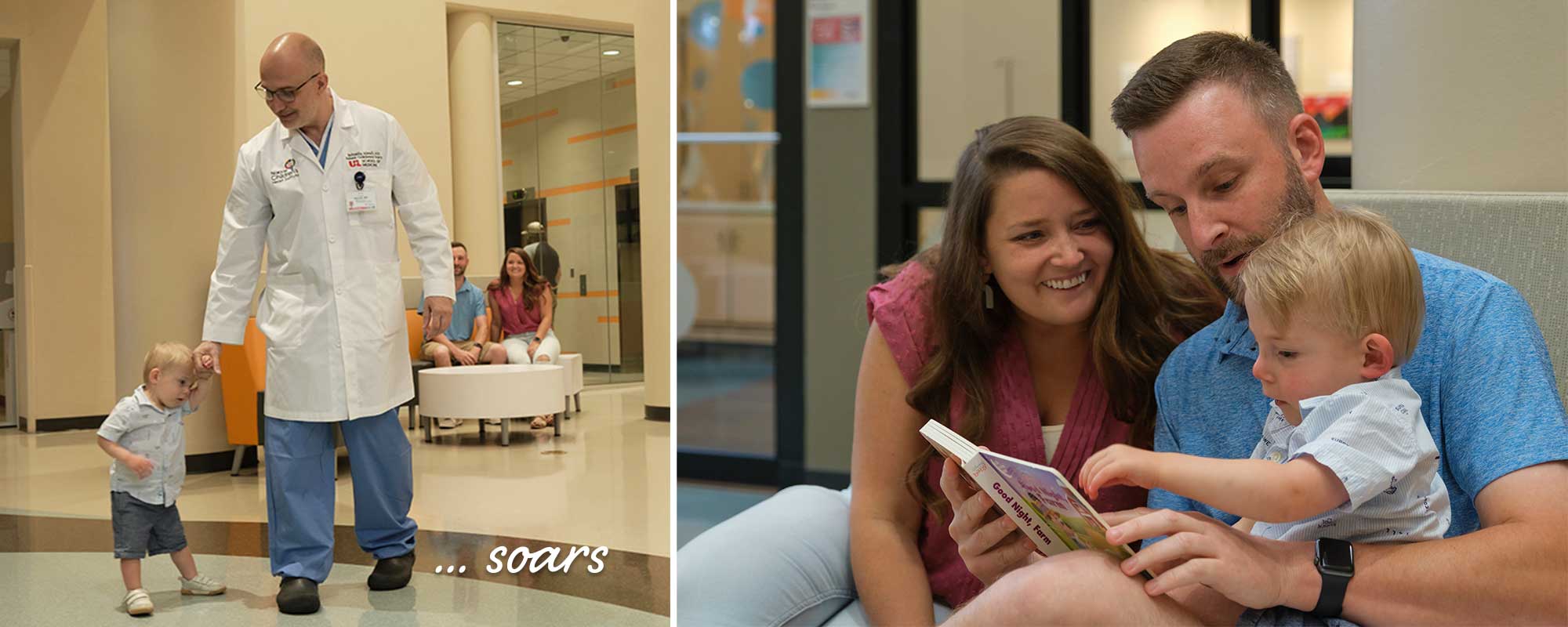
When Jessica and Jarrod Hogue left Norton Hospital without their newborn, they had no idea what to make of the following days, let alone years.
On March 12, 2021, the Hogues welcomed their baby, Hudson, into the world nine weeks early due to a very complex congenital heart defect.
As a chronic planner, Jessica had a picture in her mind of her pregnancy, delivery and child’s life. But at her 20-week ultrasound, that picture shattered as her doctor became concerned about Hudson’s heart.
The fetal cardiology team at Norton Children’s Heart Institute, affiliated with the UofL School of Medicine, confirmed that Hudson had an underdeveloped aortic arch and a hole in his heart, called a ventricular septal defect (VSD). Hudson’s doctors pinpointed DiGeorge syndrome, a chromosomal disorder, as the cause of the heart defects.
“When you get the diagnosis of a chromosome abnormality, it opens up all these other doors,” Jessica said. “The planner in me was going a little crazy because I like to know what’s going to happen, and for the first time in my life, I didn’t really know how this was going to go.”
Time to make a plan
Hudson’s aortic arch would need to be surgically repaired soon after birth or the heart would fail to supply blood to the lower half of his body. As scary as that sounded, it allowed the Hogues to make a plan.
“Immediately after that we felt at peace, because we kind of knew what we were up against,” Jessica said. “We knew that there was a plan and that [Norton Children’s was] going to take very good care of us.”
Unfortunately, the plan had to change when a follow-up appointment with Norton Children’s Maternal-Fetal Medicine showed that Jessica was at risk for preterm labor and would need to spend several weeks on bed rest. A part of Norton Women’s Care, Norton Children’s Maternal-Fetal Medicine provides care for patients with high-risk pregnancies.
Not two weeks after that appointment, Jessica began having contractions and was admitted to Norton Hospital. Every week that Jessica could remain lying in that hospital room increased Hudson’s chance for survival.
At nearly 31 weeks pregnant, Jessica went into labor. Hudson was born weighing just 3 pounds, 5 ounces. His premature birth meant that it would be much riskier to complete his first planned surgery to repair his heart.
An innovative approach to increase Hudson’s chances
But the Hogues’ care team pivoted quickly and decided on a relatively new “hybrid” surgical approachthat would stabilize Hudson sooner and increase his chance at life.
Traditionally, the choices for babies like Hudson were to either wait on heart surgery until the baby is older and bigger, or do a full repair — a very high-risk option given the baby’s fragile condition. Waiting often is unsuccessful, as the baby is likely to go into heart failure and develop complications prior to surgery. Also, performing early full surgery comes with a high chance of not surviving.
A hybrid approach, while not a permanent fix, is a safer alternative that stabilizes blood circulation, buying time for the baby to grow before the full repair.
“Norton Children’s Heart Institute has been among the earliest programs to adopt the hybrid strategy for patients with very complex heart defects,” said Bahaaldin Alsoufi, M.D., Hudson’s heart surgeon. Dr. Alsoufi is chief of pediatric cardiothoracic surgery at Norton Children’s Heart Institute.
Hudson was less than 1 month old when he underwent the hybrid operation.
“One benefit of the hybrid approach is that the baby gets to go home after the first procedure, rather than remaining in the hospital,” Dr. Alsoufi said. “Going home means fewer days in the hospital, lower costs and less disruption in the lives of families. When the full repair is done a few months later, the surgery can be performed more efficiently and accurately, leading to lower risk and faster recovery.”
Walking, talking, climbing and making his family laugh
Hudson had the second surgery six months later. With a fully repaired heart, he bounced back quickly and recovered over the next six months.
Now 2 years old, Hudson is walking, climbing on everything he can and making his family laugh.
While Jessica said Hudson has some catching up to do in development for his age, it is nothing they didn’t anticipate and are working through it with physical, speech and occupational therapies.
DiGeorge syndrome can cause issues with the immune system, calcium levels and swallowing, so Hudson has a feeding tube to ensure he consumes enough calories. He gets regular checkups.
“We’re very blessed for what we have and to see Hudson thriving so much,” Jessica said. “I hope that it gives some people encouragement that it will get better.”
Jessica recommends parents of kids with health challenges connect with support groups on social media and talk to other parents at Norton Children’s.
“I’m so glad I was at Norton Children’s when everything happened. From the moment Hudson was born to now, the doctors and nurses became like family to us,” she said.
